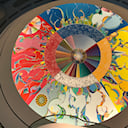What is a flash cube?
As the art of photography progressed into more demanding situations, it became apparent that more light than the ambient sources would be necessary. Initially, quick-burning, single-use devices were lit to the side of the camera lens. A bright flash illuminated the area for the fraction of a second when the camera shutter was open.
As the technology improved, the flash units were mirrored to direct the light towards the subject. Later, the flash lighting came to be mounted on the camera itself, using a battery to both initiate the flash burn as well as to boost the material to burning temperature. Think of a single-use filament in an incandescent electric light.
Later, to spare costs and to make the flash enhancement last a bit longer, the flash cube was developed in a partnership between Eastman Kodak Company and Sylvania lighting Company. It was a simple and remarkable improvement with four small single-use flash units arranged around a central pivot to allow each of the four flashes to illuminated in successive images. The "flash cube" was then discarded and a new one mounted for the next four pictures. The flash cube died off as better technology allowed flash illumination to be effected with multi-use flash units.
More Info:
en.wikipedia.org








